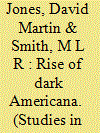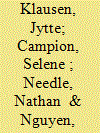| Srl | Item |
| 1 |
ID:
144864


|
|
|
|
|
| Summary/Abstract |
This article examines how the phenomenon of homegrown terrorism has evolved over the past decade. It argues that there have been significant developments that impact how we conceptualize and study it and offers two suggestions moving forward. It argues that re-branding it Islamist-inspired homegrown terrorism (IIHGT) better captures the nuances of this phenomenon and that sub-dividing it by “endgame,” the action the radicalized individual pursues creates the opportunity for a more robust analysis and provides a better way to compare incidents and identify traits that our current efforts overlook. Focusing on the action component may also provide a new way to investigate radicalization as the different endgames represent an escalation in violence, suggesting different degrees of radicalization might also be present.
|
|
|
|
|
|
|
|
|
|
|
|
|
|
|
|
| 2 |
ID:
144863


|
|
|
|
|
| Summary/Abstract |
Although past scholarship shows that group inequalities in economic and political power (“Horizontal Inequalities”) correlate with dissent, violence, and civil wars, there is no direct empirical test of the perceptual explanation for this relationship at the individual level. Such explanation is vital to understanding how integration, inclusion in power-sharing agreements, and exclusion from political power filter down to mass publics. Moreover, subjective perceptions of group conditions do not always correspond to objective group realities. We hypothesize subjective perceptions attenuate the effect of objective exclusion on support for violence in ethnically divided societies. Cross-national comparative multilevel analyses of the 2005/6 Afrobarometer dataset (N = 19,278) confirm that subjective perceptions both amplify the effect of exclusion on acceptance of violence and alter the readiness of included groups to dissent. These findings carry implications for research, state-building, and conflict management.
|
|
|
|
|
|
|
|
|
|
|
|
|
|
|
|
| 3 |
ID:
144862


|
|
|
|
|
| Summary/Abstract |
In the wake of the 9/11 attacks the American film industry took a while to react to the Islamist threat at home and abroad. From 2005, however, Hollywood responded to the threat to the homeland and the War on Terror “over there” in Iraq and Afghanistan in a variety of ways. This article examines the nature of that response and whether it evinces, as critics allege, that the American film industry reflects and shapes a capitalist and imperialist agenda. More particularly, by evaluating the cinematic treatment of both the Iraq war and the problem of surveillance, rendition, and homeland security, the analysis explores what this distinctive on-screen genre tells about how the U.S. cultural mainstream has dealt with the challenge global jihadism poses to American values. The analysis suggests that post-9/11 movie making, while sometimes bleak and often clichéd, is cognizant of the gray area morality inherent in fighting the “War on Terror,” and is still thus able to offer some possibilities for sophisticated reflection.
|
|
|
|
|
|
|
|
|
|
|
|
|
|
|
|
| 4 |
ID:
144865


|
|
|
|
|
| Summary/Abstract |
This research note presents a dynamic risk assessment model of homegrown terrorists. The model was tested in a study of convicted “homegrown” American terrorism offenders inspired by Al Qaeda's ideology. The New York Police Department model developed by Silber and Bhatt was chosen as the basis for creating a typology of overt and detectable indicators of individual behaviors widely thought to be associated with extremism. Twenty-four specific cues associated with each stage of radicalization were used to code and estimate the sequencing of behaviors and the duration of the average radicalization trajectory. Sixty-eight cases have been analyzed thus far. A decision was made to publish the initial results when it became apparent that the model was an effective tool for the evaluation of terrorist offenders.
|
|
|
|
|
|
|
|
|
|
|
|
|
|
|
|